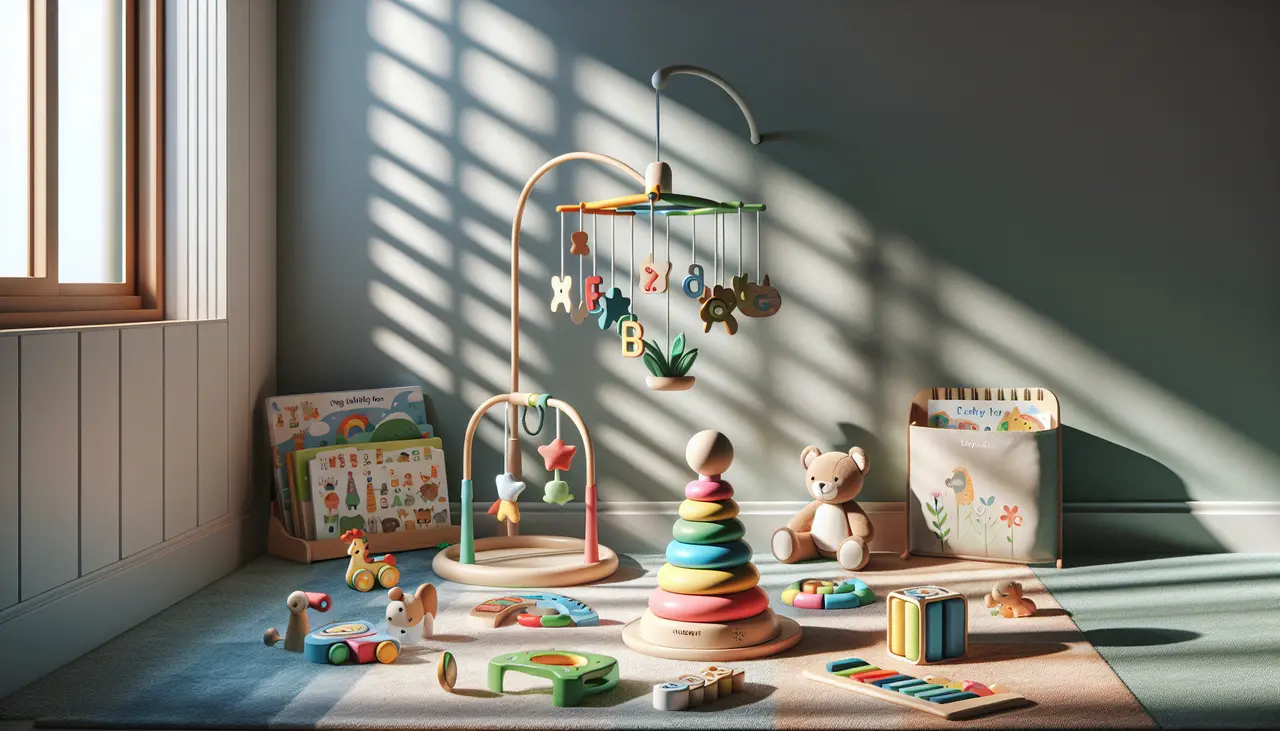Introduction to Infant Learning Toys
Infant learning toys are more than just toys; they’re tools that help your baby grow. These toys make learning fun and support your baby’s development stages. From colorful rattles that help with grabbing skills to musical toys that fine-tune hearing, infant learning toys cover all bases. They’re designed to stimulate your baby’s senses, encourage movement, and promote problem-solving skills from a very young age. The idea is simple: the more a baby plays, the more they learn. It’s about squeezing learning into every giggle and game. Remember, the best toy for your baby is one that matches their current development stage and interests.
Why Choose Infant Learning Toys? Understanding Their Importance
Choosing infant learning toys is a smart move for any parent or caregiver. Why? Because these toys do more than just entertain. They play a crucial role in your little one’s development. From the moment they’re born, babies start learning. Their brains are like sponges, eagerly soaking up new experiences. Toys designed for learning stimulate their senses, improve their motor skills, and teach them about cause and effect. For instance, a simple toy that makes a sound when pressed helps babies understand that their actions can produce results. This isn’t just fun; it’s a foundational lesson in how the world works. So, when you pick out a toy, think of it as an investment in their development. You’re not just buying a plaything; you’re helping shape their understanding of their surroundings. Plus, these toys often offer a way for you to bond with your baby, making learning an enjoyable experience for both of you. In a nutshell, infant learning toys are about combining fun with education. It’s a win-win situation where your baby gets to have fun and learn at the same time.
The Best Types of Infant Learning Toys for Early Development
When picking toys for your baby, it’s smart to think about toys that are not just fun but also fuel their learning. One great choice is sensory toys. These toys light up, make sounds, or have different textures. Why? They help babies understand the world through their senses, which is key in these early stages. Then there are motor skill development toys like blocks or simple puzzles. These aren’t just for play; they get those little hands moving, teaching grip and problem-solving. Shape sorters are next on the list. Amazing for recognizing shapes and improving hand-eye coordination, these toys prepare your little one for more complex tasks later. Don’t forget about books. Yes, even for infants. Picture books with bright colors and big, simple images can spark a love for reading and improve their understanding of language. Lastly, musical toys play a big role. They’re not just noise makers; they introduce rhythm and can improve auditory skills. Choosing the right toys makes learning a part of playtime, setting the foundation for a curious and smart little learner.
Age-Appropriate Toys: What Works for Every Stage
Choosing the right toys for your baby or toddler is crucial for their development. It sounds simple, but not every toy works for every age. Toys that match your child’s developmental stage can boost learning and fun. For babies 0-6 months, go for toys that stimulate their senses. Think high-contrast colors and toys that make noise. It helps their sight and hearing take shape. At 6-12 months, babies get more mobile. They’ll love toys they can touch, feel, and even chew on. Stacking rings and simple puzzles fit the bill, aiding in their problem-solving skills. Toddlers 1-2 years are on the move and curious. It’s time for more interactive toys. Think blocks, simple musical instruments, or anything that encourages them to explore and pretend. For kids 2-3 years old, it’s all about imagination and fine motor skills. Dollhouses, toy cars, and crayons encourage creative play and improve their coordination. Remember, it’s not about buying the most toys, but the right toys that engage and educate at each stage.
Sensory Play and Infant Learning Toys: A Perfect Match
Sensory play is a big deal for your little one. It’s all about letting them touch, see, smell, taste, and hear new things. And guess what? Infant learning toys that focus on sensory play are a perfect match for this. These toys, like soft blocks with different textures or rattles with colorful beads, help your baby’s brain grow. They make sense of the world by exploring and interacting with it. This kind of play is not just fun; it’s building blocks for learning. By grabbing, shaking, and even throwing toys, babies learn about cause and effect. They start understanding their own senses and how to use them. It’s simple — through play, they get to know the world. And the best part? These toys aren’t just beneficial; they’re a blast for your baby. So, when you’re picking out toys, go for ones that will light up their senses and make learning an adventure.
Cognitive Development: Selecting Toys to Boost Brain Power
When you’re looking for toys to boost your little one’s brain power, simplicity is key. Think about toys that encourage problem-solving. These could be puzzles that fit together or toys that require sorting shapes or colors. Such toys not only keep your child engaged but also enhance their cognitive development, teaching them to recognize patterns and understand cause and effect.
Interactive books are another great option. Books with textures or sounds stimulate your baby’s senses, making the learning process more enjoyable. They pick up on language skills, sounds, and start recognizing images and words together.
Don’t forget about building blocks. They might seem basic, but they’re fantastic for cognitive growth. Blocks help kids learn about shapes, balance, and spatial relationships. Plus, when they’re imagining what to build, they’re planning and thinking critically.
Lastly, toys that mimic real-life scenarios, like play kitchens or tool sets, are excellent for cognitive development. They encourage pretend play, which is crucial for problem-solving and creative thinking skills.
Remember, the goal is to find toys that are fun but also challenge your child’s brain in a healthy way. It’s all about balance.
Physical Growth and Motor Skills: Toys to Encourage Movement
Toys aren’t just about keeping your little one busy. They play a big role in helping kids boost their physical growth and motor skills. Think of toys that get your child moving and grooving. Push and pull toys, for example, are perfect for walkers. They encourage your child to stand up, balance, and take those important first steps. Balls of different sizes and textures invite throwing, catching, and kicking, building coordination and strength.
For babies learning to crawl, toys that move just out of reach can motivate them to move forward. Think toys on wheels or those with parts that pop up or play music when touched. It’s about making movement a fun discovery. Then, there are building blocks and simple puzzles. These might not seem like they’re for physical growth, but think again. They require hand-eye coordination and fine motor skills, building the muscles in little fingers and hands.
Choosing toys that encourage movement means you’re not just playing—you’re building the foundation for a healthy, active lifestyle. So, look for toys that make your child stretch, reach, push, pull, and chase. It’s about making those physical milestones fun to achieve. And remember, every child grows at their own pace, so let their interests guide you towards the toys that will benefit them the most.
Emotional and Social Development: How Toys Can Help
Toys are not just toys. They’re your child’s first teachers. Toys that focus on emotions and social interactions can give your little one a huge head start. These toys help kids understand feelings, learn how to get along with others, and develop empathy. Imagine a doll that can show sadness or happiness, or a game that needs players to work together to win. These aren’t just fun; they’re lessons in tiny packages.
For instance, playing with dolls can teach kids about caring and empathy because they learn to take care of something else. Board games that require turn-taking can teach patience and how to cope with losing gracefully. When kids play together, they learn important social skills like sharing and teamwork.
Using toys for emotional and social development is smart parenting. It transforms playtime into a learning session, all while your child thinks they’re just having fun. Remember, the goal isn’t just to keep them busy but to help them grow into well-rounded individuals.
Tips for Choosing Safe and Effective Infant Learning Toys
When picking learning toys for your little one, safety and effectiveness should be your top priorities. Always check that toys match your infant’s age range, which is clearly marked on the packaging. This ensures the toy is suitable for their developmental stage. Opt for toys made from non-toxic materials; babies explore with their mouths, so it’s crucial the toys are safe to chew on.
Avoid toys with small parts to prevent choking hazards. If the toy can fit through a toilet paper roll, it’s too small for infants. Also, consider toys that stimulate multiple senses – bright colors, different textures, and sounds all help in your baby’s development. Simple, high-contrast pattern toys catch infants’ attention and are good for visual development.
Look for toys that encourage exploration and problem-solving, like shape sorters or simple puzzles. These enhance cognitive skills by teaching cause and effect. Toys should be durable and easy to clean, considering infants’ rough handling and the need for hygiene. Finally, read reviews and recommendations from other parents. Their experiences can provide valuable insight into a toy’s real-world durability and educational value.
Conclusion: Balancing Fun and Educational Value in Toy Selection
When picking toys for your infant, striking a balance between fun and educational value is key. It’s not just about filling the room with toys; it’s about choosing those that spark joy and curiosity in your little one. Remember, the best toys are those that match your child’s developmental stage and encourage learning through play. Whether it’s a simple set of blocks that teach about shapes and balance or a musical toy that introduces rhythm and sound, each toy has the potential to be a stepping stone in your child’s growth. Don’t get caught up in the latest trends or the most expensive toys. Often, it’s the simplest items that hold the most educational value. Keep an eye out for toys that encourage creativity, problem-solving, and motor skill development. These are the toys that not only keep your child engaged but also support their overall development. In the end, choosing the right toys is about giving your child the best start in life by combining the joy of play with the power of learning.


